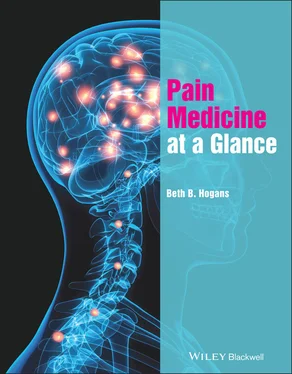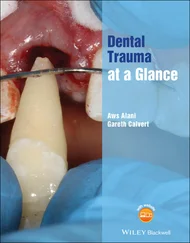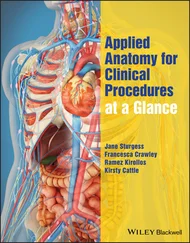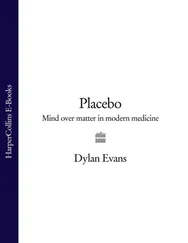Table 9.1 Pain alphabet.
| Pain |
| Quality |
| Region |
| Severity |
| Timing |
| Usually associated with |
| Very much better with |
| Worse with |

Figure 9.1 The numerical rating scale.
In the acute setting, the pain history may be quite brief. In this context, the biomedical modelis relevant: what are the proximate causesof a pain problem, what are the pertinent medical conditions. Clinically, we think in terms of “finding a pain generator,” i.e., locating the primary afferent nerve endings activated by an injury. The quick pain history and the biomedical model are typically insufficient when pain is longer‐lasting.
In the chronic pain setting, the insightful provider finds that biopsychosocialhistory gathering is often more effective. Time is spent establishing rapportand building a relationship (Cole and Bird 2013). The patient with a persistent pain problem will have more extensive relevant experience: prior testing, interventional, conventional, and alternative therapies, and personal perspectives on the cause of their pain. Understanding the patient' s insightinto their pain strengthens therapeutic alliance (McCormack et al. 2013) ( Figure 9.2). Recognizing what the patient values and genuinely enjoys in life becomes essential when implementing a chronic disease modelto change behavior, as is necessary in managing persistent pain‐associated conditions. Knowing that patient wants to return to specific sports, hobbies, or work‐related activities will make discussions of “engagement in physical therapy” or “maintaining a moderate exercise program” more successful, couched in terms of returning to valued activities. This is referred to as motivational interviewing, discussed later (Miller and Rollnick 2002).
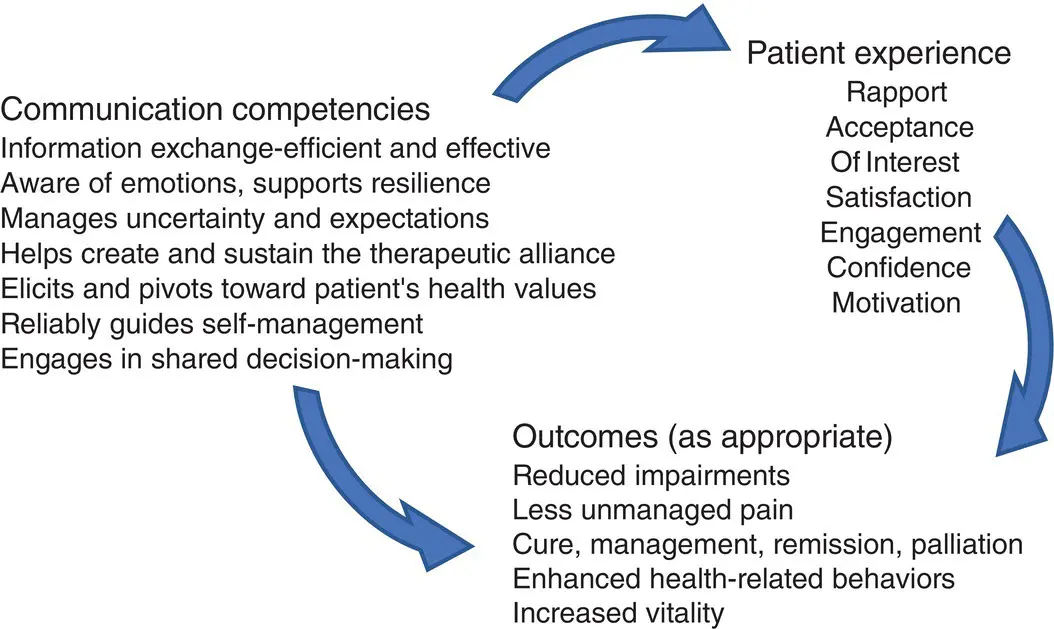
Figure 9.2 In the effective patient‐provider relationship, there are many forms of communication, patient experiences, and potential outcomes that impact pain care.
For those with cognitive impairmentsand dementia, it is important to utilize situationally appropriate observations. Pain behaviors in older adults can include irritability, social isolation, grimacing, groaning, sweating, tachypnea, tachycardia, guarding, and limping. For more detail, see Chapter 51.
For children, it is important to conduct an age‐appropriate pain assessment. Children over the age of 7 should be assessed for capacity to utilize the numerical rating scale. From 4 to 7 the FACES scale is more appropriate. Infants and pre‐verbal children require behavioral pain scales such as the FLACC and the NIPS. Please see Chapter 50for more details.
Some patients will become irritable when socioemotional barriers are explored. Others will express sincere appreciation that you want to understand their experiences more fully. By empathetically entering into the patient's experience you can lighten their burden while fostering genuine connection that will be a strong foundation for future progress (Rogers 1967). More in Chapter 10.
The quality and quantity of sleep has a direct and profound influence on pain persistence and severity. It is critical to ask about sleep at the initial visit and to check back about sleep quality and quantity at subsequent visits, see Chapter 25for details.
Pain has a profound effect on multiple domains of function as noted in Chapter 1, Figure . Functional assessment in patients with pain, usually focuses on specific domains, noted here in Table 9.2.
Table 9.2 Pain functional interference.
| Does pain interfere with your:“Work at home”?“Work at work”?Care for self?Relationships with family?Friendships?Social or civic activities?Enjoyment of life?Sleep?Mood? |
The degree to which the patient will recognize aspects of the biopsychosocial model is expediently explored with an educational handout about the model. The patient, once introduced to the concepts, see Chapter 8, is presented with a check list, such as that in Table 9.3, providing the opportunity to endorse multiple complicating factors.
Table 9.3 Biopsychosocial model: with examples for each Bio – Psycho – Social model: the details.
| Biological |
Psychological |
Social |
| Disc/vertebral degeneration |
Depression |
Smoking |
| Facet joint arthritis |
Anxiety |
Poor ergonomics |
| Ingrowth of pain‐type nerve endings |
PTSD |
Lack of exercise |
| Ligamentous stretch or hypertrophy |
Post‐TBI |
Stress |
| Muscle strain |
Other mental illness |
Physical demands |
| Radiculopathy |
Dysphoria |
Poor sleep |
| Altered central pain processing |
Somatic focus |
De‐conditioning |
|
Low self‐efficacy |
Lack of social support |
|
Substance abuse |
Expectations |
|
Personality d/o |
|
Openness to treatments – foundations of MI
A useful way to assess openness to treatments is, besides asking the patient what treatments they are interested in, is to use a check sheet as part of the check‐in or counseling process. See Chapter 16and Appendix 5.
Social history and work–life
The role of professional work–life in the social history has fallen from vogue but serves a central purpose in understanding the patient's everyday jargon and cognitive frame.
A check‐in form (or tablet protocol) that efficiently assesses pain can allow a provider to track changes over time, screen for opioid abuse risk, and provide valuable diagnostic information, in addition to conveying information about other prescription medicines, dietary supplements, exercise patterns, social habits, and comorbid conditions.
1 Cole, S.A. and Bird, J. (2013). The Medical Interview: The Three Function Approach with Student Consult Online Access, 3e. Philadelphia, PA: Saunders.
2 Frankel, R.M. and Stein, T. (2001). Getting the most out of the clinical encounter: the four habits. The Journal of Medical Practice Management 16 (4): 184–191.
3 McCormack, L., Treiman, K., Olmsted, M. et al. (2013). Advancing Measurement of Patient‐Centered Communication in Cancer Care. Effective Health Care Program Research Report No. 39. (Prepared by RTI DEcIDE Center under Contract No. 290‐ 2005‐0036‐I.) AHRQ Publication No. 12(13)‐EHC057‐EF. Rockville, MD: Agency for Healthcare Research and Quality.
4 Miller, W.R. and Rollnick, S. (2002). Motivational Interviewing: Preparing People for Change, 2e. New York: Guilford Press.
5 Murinson, B.B., Agarwal, A.K., and Haythornthwaite, J.A. (2008). Cognitive expertise, emotional development, and reflective capacity: clinical skills for improved pain care. The Journal of Pain 9 (11): 975–983.
Читать дальше
